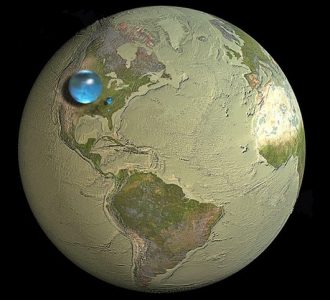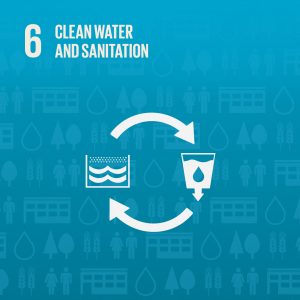“Basically, each of us is a blob of water with enough macromolecular thickening to give us some stiffness and to keep us from dribbling away.” David Suzuki, geneticist and Professor Emeritus, University of British Columbia
Wow! I never thought of myself as ‘a blob of water with enough macromolecular thickening to keep me from dribbling away.’ That may not be a complete description of us as Homo sapiens, but it is accurate. Our bodies are about 60% water after all.
I expect that everyone acknowledges water’s essential role in life on Earth, but I doubt many people with ready access to freshwater spend much time thinking about it, except when there is way too much of it (hurricanes Irma and Harvey) or way too little of it in times of drought like the summer and fall of 2016; or when we are enjoying ourselves on a river, lake, bay, or ocean. We turn on the tap and potable water flows. Most of us flush our toilets with drinking water and water our lawns with it, too.
But access to sufficient supplies of clean, fresh water to keep each of us blobs of water healthy is very uneven in the United States and around the world. For those suffering from water poverty, clean, fresh water is always on their minds.
Residents in Flint, Michigan, will suffer the consequences of lead contamination in drinking water for a long time. A concentration of 5 parts per billion (ppb) of lead in water is cause for concern. In Flint, lead concentrations were 27 ppb. Flint is by no means the only American community suffering with lead-contaminated drinking water. For example, Environmental Protection Agency data shows that nearly 20% of water systems nationally test above the agency’s action-taking level. In New Jersey, eleven cities were found to have a higher proportion of children with dangerous lead levels than Flint.
Many Native Americans live in desperate water poverty, as this New York Times piece documents. They face serious shortages of freshwater, suffer the effects of inadequate or nonexistent sewage treatment, and are exposed to water and soil contaminated by uranium and arsenic, byproducts of uranium mining.
Internationally, some progress has been made. Since 1990, 2.6 billion people have gained access to better drinking water, but over 660 million are still without. 2.4 billion people still lack access to a toilet and proper sanitation. Every 90 seconds, a child dies from a water-related illness. It is expected that by 2025, about 1.8 billion people will suffer from water scarcity, and two-thirds of the global population will be living in water-stressed conditions. By 2025 humans may be appropriating a shocking 70% of all available freshwater, putting ecosystems at further risk.
The Earth is a closed, limited system, and all the water on Earth has been here from almost the beginning. Some theories say water arrived by asteroids and comets colliding with Earth. A recent theory postulates that under the right high pressure conditions reactions between liquid nitrogen and silicon dioxide in the Earth’s upper mantle can form water. In any case, we drink the same water the dinosaurs did. What we have is all we have, and the freshwater available for ourselves and other living things isn’t very much, even as human population growth and demands on water have exploded over the past 100 years. In the 20th century, human population grew 300% while water demand grew 700%.
Only 2.5% of all the water on Earth is fresh. Of that freshwater, 70% is locked in glaciers and icecaps. As global warming causes glaciers and icecaps to melt, that water drains to the ocean and becomes seawater. 28% of freshwater is groundwater. Only 1.2% of all freshwater on Earth is surface water, found in lakes, rivers, and streams. That’s 1.2% of the 2.5% of the Earth’s water that is fresh. Surface freshwater meets almost all the needs of organisms that rely on freshwater for survival. A shocking 0.007% of the planet’s water is fresh, renewable, and accessible to meet our needs.

USGS depiction of water on Earth.
Check out the U.S. Geological Survey webpage which gives a much clearer view of this picture , with its three blue spheres representing a) all the water in, on, and above the Earth, b) liquid fresh water, and c) freshwater in lakes, rivers, and streams. It’s more than it appears since these spheres are seen in comparison to the size of the planet. The smallest, barely visible blue sphere is 35 miles high. Still, that’s it. That is all we have in the world.
There are many more water issues than I can delve into here, and the economic, environmental, and public health implications are significant. For example:
- It remains legal and commonplace to treat rivers, bays, and oceans as waste dumps. Most discharges are regulated in some way, but they are still discharges of pollution. We use waters to dilute pollution from factories and sewage treatment plants. Dilution is not the solution to pollution.
- Then there is the issue of plastics, a substance that only came into everyday use in the 1950s when the first plastic bags were introduced and plastic packaging became more popular. In 2017, plastics are omnipresent. The deliberate dumping of trash and littering – in particular single use plastic containers including plastic water bottles – results in an astounding 19 billion pounds of plastic added to the ocean every year. But, it’s not just our ocean’s that are impacted. Shocking results of research conducted by Orb show that 94% of tap water samples tested in the United Stated indicated the presence of microplastics.
- Stormwater runoff carrying contaminants from city streets, suburban lawns, construction sites and poorly managed farmland is another major source of water pollution.
- Water privatization, corporate control of water for profit rather than water being held in public trust for the people by the people, is a major threat to conservation, ecosystem-based management, and water justice – the effort to secure sufficient access to fresh water as a human right.
Experts around the world in many disciplines are aware of the water crises we face as a global community. International goals have been set to address these challenges. The 17 United Nations Sustainable Development Goals include a water goal to “ensure access to water and sanitation for all” by 2030.
Here on campus we have many faculty members working on water issues, experts across a wide range of disciplines. The Auburn University Water Resources Center (WRC) facilitates interdisciplinary research on water. Alabama Water Watch, housed in the WRC, has a 25-year track record of training and engaging citizens to monitor their local waterways and take action to protect them. The student group Auburn for Water is actively engaged in efforts to address our global water crisis.
As a society, we know what the issues are. We know what is at stake. We even know what needs to be done. As physicist Neil deGrasse Tyson puts it, “There are no scientific or technical obstacles to protecting our world and the precious life it supports. It all depends on what we truly value, and that we can summon the will to act.”
The very limited supply of fresh, accessible, and renewable water is sufficient to sustain every human and non-human ‘blob of water with enough macromolecular thickening to keep it from dribbling away.’ If we truly value water and do summon the will to act, we will limit human population and water demand, pay attention to ecosystem functioning on Earth, and act in accord with what we know to be in the best interest all of life on Earth.
Learn about the SDGs & AU and our contributions related to this post.





